(August 22, 2015) And that my friends was China. A trip made special by the best traveling companion a father could hope for. Thanks to all who read along and happy trails yourselves.
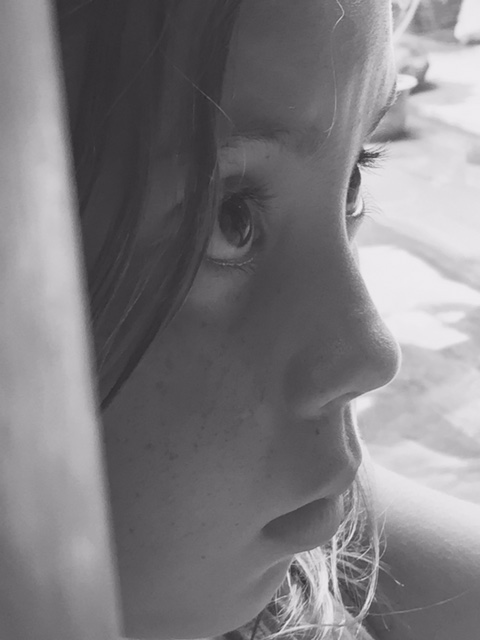


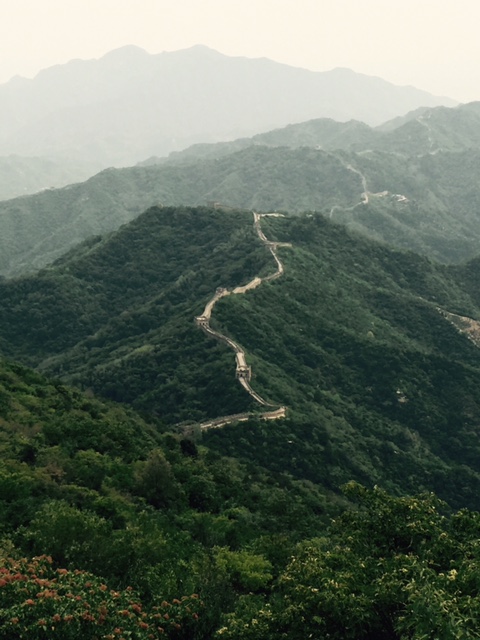
(Aug 22, 2015) The Great Wall is well named. When all its branches are factored in it stretches 13,170 miles. That’s a lot of wall. It was built, ignored, rebuilt, and re-ignored over a parade of centuries and dynasties. More than 1 million gave their lives for its construction. It’s purpose was to keep out the trouble that always seemed to come from the north. For that it was impractical. A concentrated attacking army will always overwhelm isolated wall garrisons. Through force, threat or bribery. No, the wall succeeded elsewhere. As that of a radar and an early telephone. Manned beacon towers were placed every couple of kilometers. A structured system of smoke and flag signals in place. When a threat was recognized, the message was sent down the line. Tower to tower. In that way a warning could be sent at the speed of 800 miles a day. In other words, the great tripwire.
In the east we jumped on a bus that made its way to Mutianyu from Beijing. Here 3 miles of wall masonry had been restored for the tourist trade. Regardless it is magic to follow as it piggybacks along the crest of a mountain range. Put in the sweat and you will arrive at the end of restoration. Keep going for a primer on what 400 years of nature’s conquest is capable of.
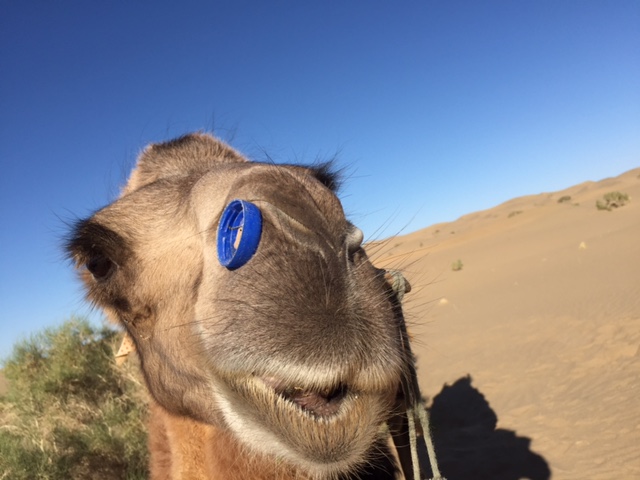
(Aug 4, 2015) The plan to create a remembered past. Catch a one a day train up a narrow River Valley. A train for miners to a mine. From there bum a ride 20 km up to an alpine valley. And a hike of three hours to the July 1st glacier at 14,000 feet. Why? That was the day Fumiko delivered, albeit two weeks late. In the midst of a thunderstorm. On this day though the miners were enthusiastic for their digging for the 7 AM train left at 6:25. Once again we were late. But a little early for disappointment, so we jumped on the adage and headed west on a bus.
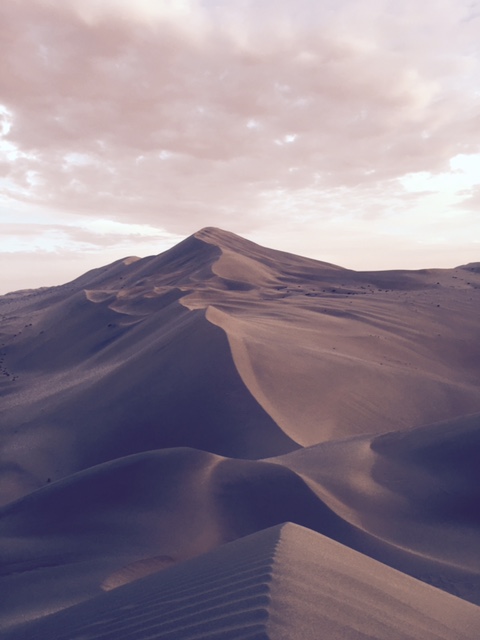
Dunhuang is surrounded by dunes. Hollywoods version of them. Large and wind textured into wrinkles. My astronomer tells me that there are more stars above then grains of sand on earth. Looking around Dunhuang clarifies infinity. On the way to our guesthouse Fumiko spotted a camel. Consolation. Within three hours we had three camels for three days. The double humped variety as opposed to the single humpers. Bactrian rather than Dromedary for the name droppers. Our guide was Mr. Li, a man prone to silence in any language. Which was OK. I like my deserts quiet. One camel for supplies, one for Fumiko and one for myself. Mr. Li seemed inclined to lead by walking. I boarded. Some days fortune and misfortune seem to be a couple. Today it was camels and glaciers.
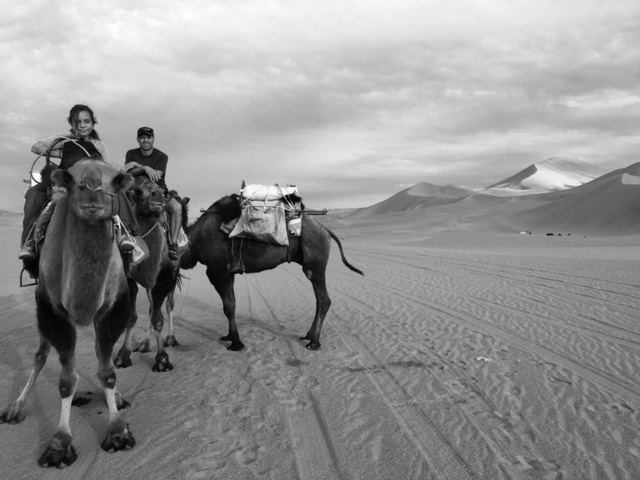
Day two. Hours on a camel saddle seem to support Mr. Li’s position. Fumiko is still whooping though the temperature has 100° in its review. My courtship is with Ali, the number three transport camel. He demands a physical relationship while I want to give our love some distance. Symbolically Ali is tethered to my saddle by a rope. The rope is attached to a stick that passes through his nostrils. It is a branched on one end. A holed plastic bottle cap against the branch prevents the stick from repassing through the nostril. The rope is never taught. Slackness is a measure of his affection.
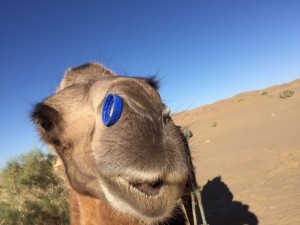
Ali’s head is Siamese to my hip. His whiskers sewing needles. His breath sulphered and decomposing. When there is an itch, either my leg or back suffice for Ali’s need. But the test of our love is the sneezing seizures. Usually a series of seven by count. Camel snot has both a sheen and volume that are a marvel. The series usually begin at my leg, move up my arm and end at my neck and face. Their blasts feel weighted. Our love is on his terms.
We halt for lunch. Using the camel saddles and a bush Mr. Li creates a shade tarp. The wind resists. Ingeniously he ties rope to sticks and buries them lengthwise in the sand. From this anchor the rope to the saddles is strong, preventing them from toppling. I catalog the technique.
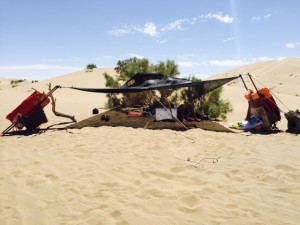
Lunch is cup of noodles and watermelon. I failed to share with Ali. Perhaps stung, he wanders off. And off. And off. With the others. Mr. Li mutters a sour oath. And goes looking. Several hours ago. All of their return is of much interest to Fumiko. But right now the sands are presenting their canvas to the clouds. From my shade perspective Mr. Li and love can take all the time they want.
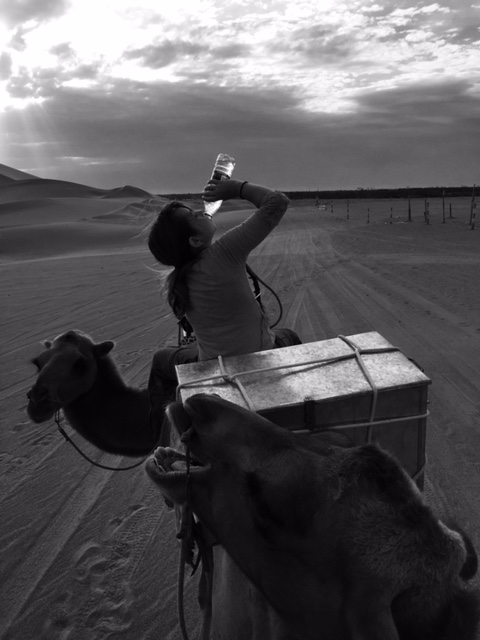
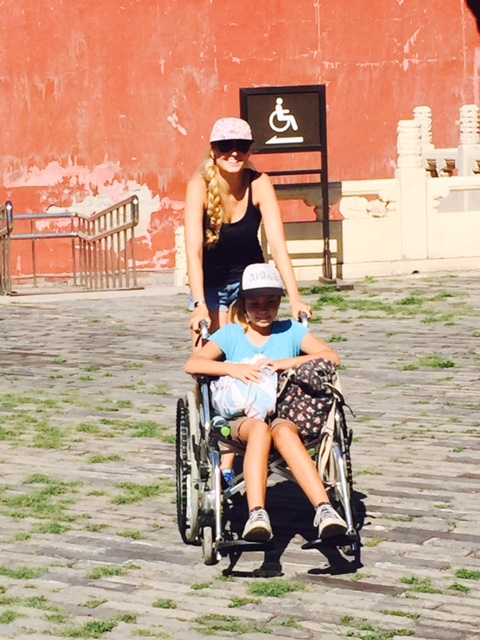
(Aug 16, 2015) 10 observations (which might be inaccurate).
1. The vast majority of the taxis run on natural gas.
2. The method of tracking foreigners movements is clever. When you check in to a hotel it is entered into a national police database by the hotel clerk. When you check out the same process. You can’t check in to a new hotel until your previous check out has been noted in the computer.
3. Han Chinese (92% of all Chinese) can only have one child by law. If the next generation husband and wife were both from one child families they can have two children. Ethnic minorities can have as many children as they want.
4. A crosswalk is the Chinese symbol for a target. Arrows come from 360°. The bull’s-eye is the pedestrian.
5. 95% of relationships between a Chinese and a foreigner are between a Chinese woman and a foreign male.
6. 60% of Chinese males smoke while only 3% of females do. No smoking signs are only for decoration.
7. A line is not a straight thing leading away from what is being waited for. Rather it is a surge from any angle possible to get to what is being waited for. The more physical contact the better organized the line is.
8. Every youth hostel has a dog or cat in residence, the uglier it is the more time a 12-year-old must spend with it. To the tune of hours. It is a patience Boot Camp.
9. Turn on the television and chances are you will be watching a World War II drama. A complicated time in China. The Japanese, the nationalists under Chiang Kai shack and the communists under Chairman Mao we’re fighting each other and each other. Regardless the drama will play out along these lines. The Chinese were heroes and self-sacrificing. The Japanese incompetent. Contrary to popular history.
10. Many, many Chinese cars have red ribbons tied to each wheel as well as the sideview mirrors. These ribbons effectively ward off the bad luck of car crashes.
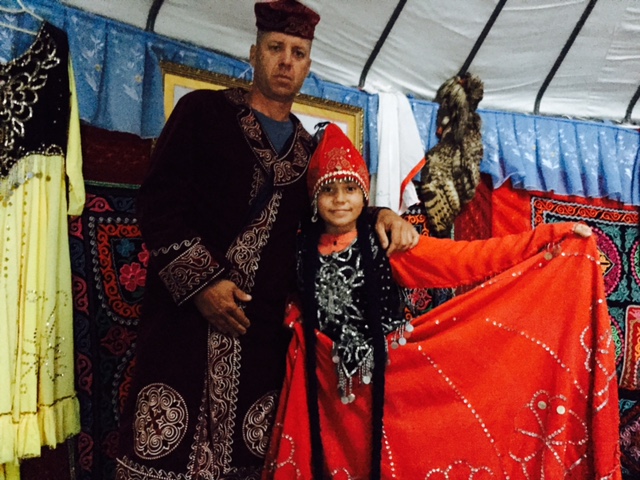
(Aug 18, 2015) Staying in the yurt of a kazak family for a few days. Formally nomads now settled in a village by order of the government. The yurt on the ridges above Tianchi lake. A stunning body of water now drowning in mass tourism. The yurt was enough away from all that.
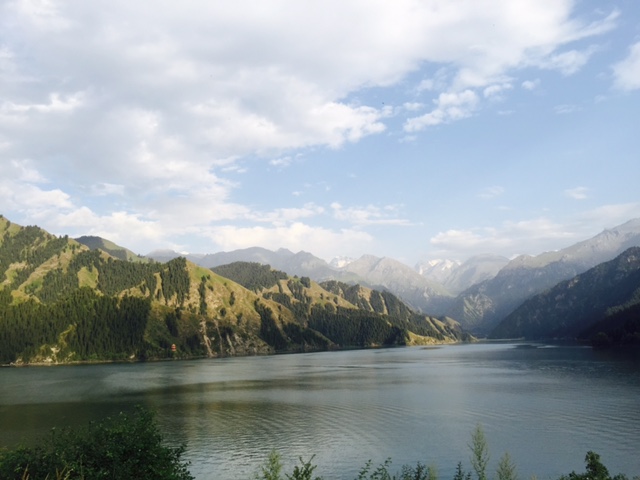
Tianchi Lake also known as heavens lake. Made famous in the book “From Heavens Lake” by Vikram Seth not too far from the border with Kazakhstan
Alot. As we spent the next 48 hours simultaneously vomiting and shitting.
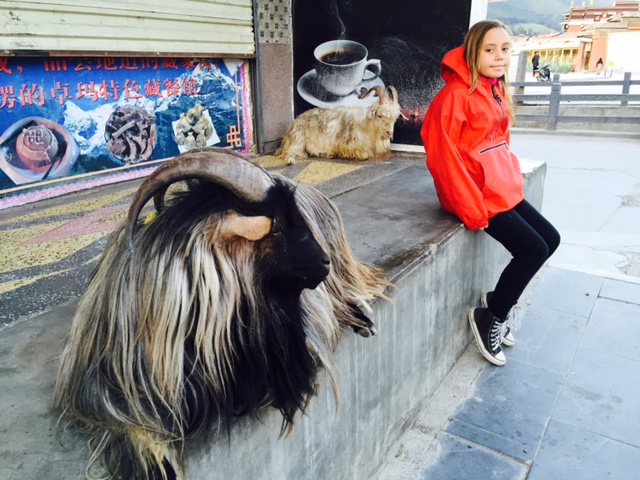
Xihte (pronounced She a hey)
(Aug 11,2015) An entire region bottled into a town. Temples and Han Chinese to the southern blocks. Central, Muslims and their minarets. And to the north Tibetans and their grand Labrang monastery. Home to 3000 burgundy clad monks. Protected by walls of prayer wheels. Which are spun by the pious completing their clockwise 3 km circumambulation. The spin spirals the prayer upwards to those that listen. The particularly devout can take days to loop. Their forward progress restricted by a bodily prayer. It’s brutal physiology basically, standing with hands clasped above head, to the knees and then a forward belly slide. Repeat. The length of their body trunk measures their progress. Shredded clothes witness to the effort.
We stayed in the Tibetan section. Their hospitality is well-known to me. And they cater to that quirky Western habit of a separate meal for breakfast. An omelette to break up our consecutive noodles for breakfast streak.
Labrang Monastery is set in a narrow river valley. Significant temperature swings accompany the suns restricted presence. The river itself is not picturesque. Tamed by concrete edging and polluted by the Chinese habit of throwing trash where it pleases. Averting one’s eyes from the river though brings nothing but beauty. Yaks dot the hillsides. Goats wander the streets. All is peaceful.
The monastery offered an English tour. We were the only takers. Our tour guide was a 26-year-old man named Torchin. There was something about him. Just one of those people whose personality is well-suited to the world. He had become a monk at 12 years old, though seven is the youngest age of admission. Torchin was a monk for life. No smoking, drinking or sex during that life. A one-shot deal. Blow it or walk away and the door to monkhood closed. It can never be reopened. Torchin’s path seemed devoid of doors.
Onward to the main temple. Torchin led with a continual Batman cape maneuver with his settling robe. Chinese tourists sought him out as we crossed the grounds. One asked about how to deal with altitude. Others just wanted a photo with him. He had time for everyone. All children we passed received a touch on the cheek with a murmured blessing. There was something about him. All noticed it.
At the main temple Torchin explained the brown band around every Tibetan temple. Branches laid horizontally, ends protruding and greatly compressed. “Tibetan air-conditioning. Air comes in cool in the summer, warm in winter”. Ambience for the 1500 monks whose prayer day commenced at 5:30 AM. “Where did you learn your English?” “I taught me.” Which completely cracked him up. When he had no answer. “OK, I don’t know”. More laughter at the elusiveness of knowledge. From Fumiko. “Do you have a phone?” “I have an iPhone. We Tibetans love iPhones. They are the only ones that download the Tibetan language.”
And then our time was over. We had seen all Torchin had to show us. He smiled and said “I go now.” With that he turned and walked away. Our time too brief. I wanted to prolong our time together. I won’t say he was holy. I never met a human being who truly was. I will say that he took the teachings of his religion and personified them more than any other I’ve met. Humility, detachment, compassion, openness, humor and presence. All were there. It’s not often you meet someone who shows you a way by example.
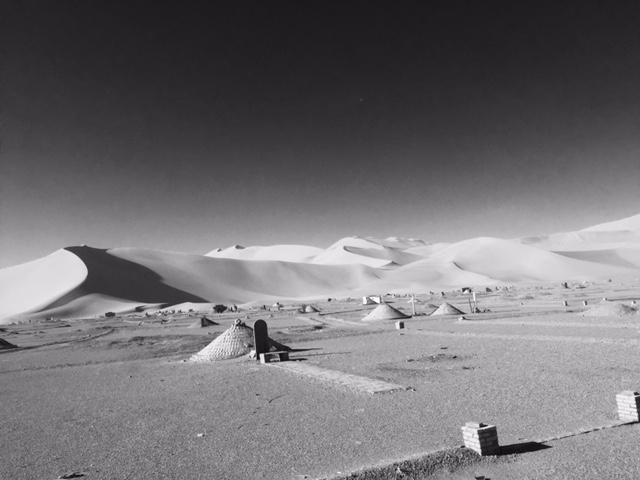
(Aug 11, 2015) The road was a mess. The bus’s suspension worse. Every pothole powdered my spine. Of course Fumiko slept on. Her head pivoting to wherever gravity took it. Most everyone else was conscious saudemasculina.pt. The groans from the wounded synchronized with the impacts. There were hours yet to go. I looked across the aisle at a young boy. His cheeks impossibly chubby. I watched fascinated as those cheeks registered every potholes slam by rippling. Someone started to vomit. Some days the road is a little too long.
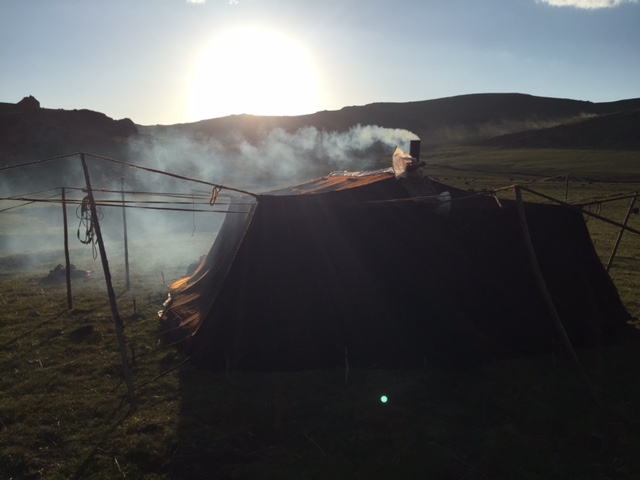
We find ourselves in Langmusi, a town of high elevation. I have promises to keep. With Fumiko a horse ride is a request on repeat. My capitulation early. “Liyi I understand you have horses”. “Yes.” “My daughter and I would like to go for a ride”. “Three days OK?” “Absolutely”. Always the attraction to suffering through distance. “I have five women leaving tomorrow”. “Perfect, my daughter is ready for some sisterhood.” “But I think you are too fat”. “I sensed discrimination”. “You are over 85 kg I think?” “Not by much”. “85 is too fat for a Tibetan pony”. “Fat is a strong word.” “You must walk”. I smiled. “Of course, I will walk. All day will I walk”.
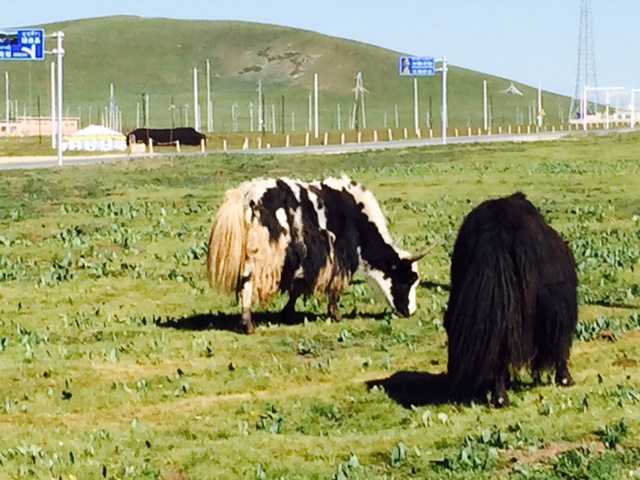
On our last horse ride Fumikos horse kicked me solidly in the shins. The resulting swelling was such that I watched for birth. My two instead of four was an unexpressed relief. The night before Fumiko was unconfined excitement. The only shadow were her sulphur belches. A stomach in discontent or giardia. The belches grew into vomiting through the night. By morning I was ready to call it. But the hero of the story was having none of it. A bland breakfast. A last vomit, a mount up and a pronouncement “I’m OK now.” And so she was.
The valley started wide and green. An overgrown golf course. Ideal for nomads and their grazers. The ponies climbed toward the pass at 2.5 mph. Hiking is slightly faster so I was free to roam. Bending wildflowers in pursuit of my own vistas. Laying amongst them. The fastest way to stilling ones entirety. Besides when I walked next to the horses I felt like Monty Python’s coconut guy. We rounded a bend to an explosion of yaks. The green spotted black. Their strangled bellows emanating from no obvious exit.
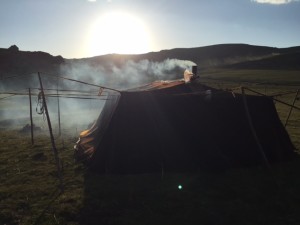
Yaks are central to the Tibetan nomads existence. Fire, meat, tents, cheese, clothes, milk, transport and yogurt all source at the shaggy yak. I’m sure there is plenty more. Their numbers parted as we climbed to the pass. Upon cresting an ambush of white. A thousand displeasured sheep screaming “bad” poured down. Beyond them a valley thick with yak and our home for the night.
Home is where your tent is. This tent was made from yak hair. Think inch thick burlap. 20 panels of it. Every year a panel is replaced. A full recycling takes taking place every two decades. Enter through the front front flap. To the right a raised sleeping platform made of dried mud. Covered in branches and then again in carpets. To the left the kitchen and the yak dung pile. Central is the small dung stove. The roof is seamed to let the build up escape. Rules. No shoes on the bed. No pointing your feet at the stove. And no combing your hair inside. Total size, maybe 18 x 18. Slept 10 snuggly.
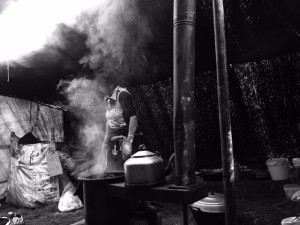
Our host was a petite Tibetan woman with popeye biceps and an elevated work ethic. I offered to help with dung collection. For the experience you know. As did a French woman with the endearing name of Auld. Think New Year’s. Our host sized us, then tossed some baskets. She lifted her rake and it began. But first a dung education. Dried dung burns, and burns well. Some methods of drying. Hand plop dung onto walls. When it falls off it is ready. Or pile it into mountains. Remove dried layers. Here on the grasslands spread thinly by hand when wet. After four days rake it up. Which is what we did. And did. Long past experience, well into work. Sweating. Huffing at altitude. Our raker grinning maniacally. I straightened looking for a break. Fields of dung spread far before me. A raker grunt brought me back to my pile.
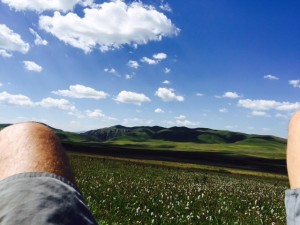
There were breaks. We tried to milk a yak. Sunscreen lubricated fingers a modern deterrent to effective nipple tugs. We tried the sling. Not evolved since David had a go at Goliath. Tordan, our guide, had a range of 300 feet, accurate at 100 feet. The stones used to drive off wolves and move sheep and yaks in a desired direction. We simply embarrassed ourselves in the sling department. We were shown where the Tibetan mastiff’s were staked and the range of their leashes. Warned that they attacked all that was strange. We being the strangest things out here.
Night came down. A wheat dough was stretched into loops. Similar to taffy. When the loop threatened the floor it was handplucked into bite-sized segments. Then flung into a boiling soup pot. Eight sets of fingers making short work of the process. The tent warmed with the stove and activity. A dot of comfort on a cold plain.
The morning with its shock of 10 people in one bed. Morning constitution in a communal ravine. A ride to a mountain and its subsequent climb. Respectable at 15,000 feet. Fumiko educated in the “to that rock and rest” approach to mountaineering. A father’s pride at her summiting. On that summit prayer flags letting the wind carry their words aloft. Surrounding giant wooden arrows plunged into the high point. Don’t know why.
Then yet more hours in the saddle to another nomads tent. This one set in a red rocked canyon. Large horned yaks standing sentinel on narrow ledges looking down on our progress. Calling to mind Greek myth and Minotaurs. I arrive out in front thanks to Tordan’s constant pointed out shortcuts. Off trail in the wildflowers and skulls. Fumiko the last to camp. Her horse the unfortunate victim of an early lobotomy. It’s gait that of a zombie on the move.
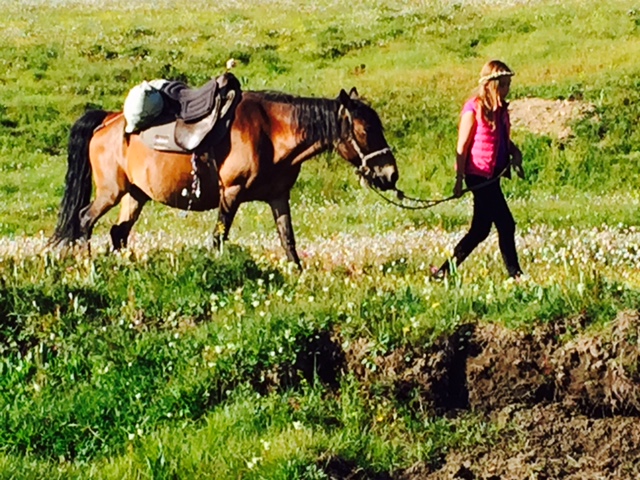
There was more. A carbonated spring, a bloated boar, a garland from purple robe and a runaway truck. But I’ve gone on long enough. Suffice it to say Langmusi eventually arrived in our sights. As we closed in Tordan dismounted and walked beside me. We were the same age and I enjoyed his comradery Though we only had about six words in common. I affectionally patted his shoulder. He smiled and took my hand. And that is how we walked into town.
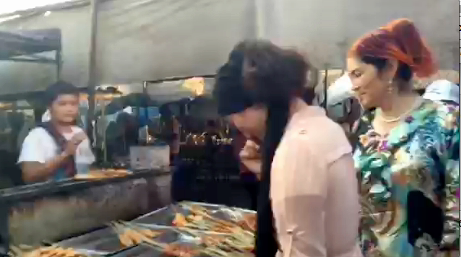
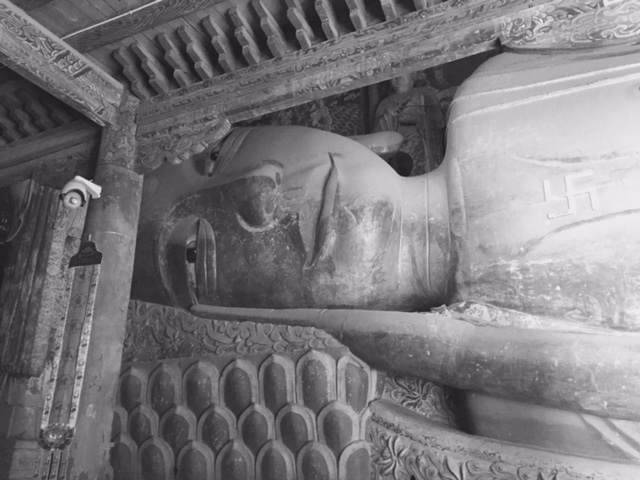
Arrival in Zhangye at 5:00 PM. A tight ship. Early plans for tomorrow. 5:15 in the guesthouse. The temple with a promising Buddha closes at six. Dump the packs. “Let’s go.” “But dad I gotta pee.” “Hustle” “Can’t we relax?” “The Buddha calls.” “It’s close, we can walk.” 5:30 where the hell is it? The maps insane. Flag a taxi. Much, much further. The map was insanely optimistic. 5:45, the front gate. $.80 to the driver. Tickets into the temple. I tell Fumiko to bend her knees. Anyone under 1.40m is half price. The ticket lady looks at the clock. My smile that of a supplicant. Her fingers move to separate perforation. Were in.
Slowly he makes his way to our adjusting eyes. “Da bigger da Buddha da better” goes the old saying. No argument. This Buddha is much better. Stretched out on its side. Like your favorite position for watching TV on the couch. Not sitting like your conventional Buddha. This Buddha has been comfortable for centuries. And at over 100 feet long it is bigger. A swastika adorns it’s chest. Not Adolf’s stolen aberration, but a reverse wheel of life. The eyelids seamed to limit the release of light. The hair blue indicating the highest levels of enlightenment. It’s belly hollow, which allowed neighborhood kids to play inside up until 50 years ago.
(Aug 5, 2015)